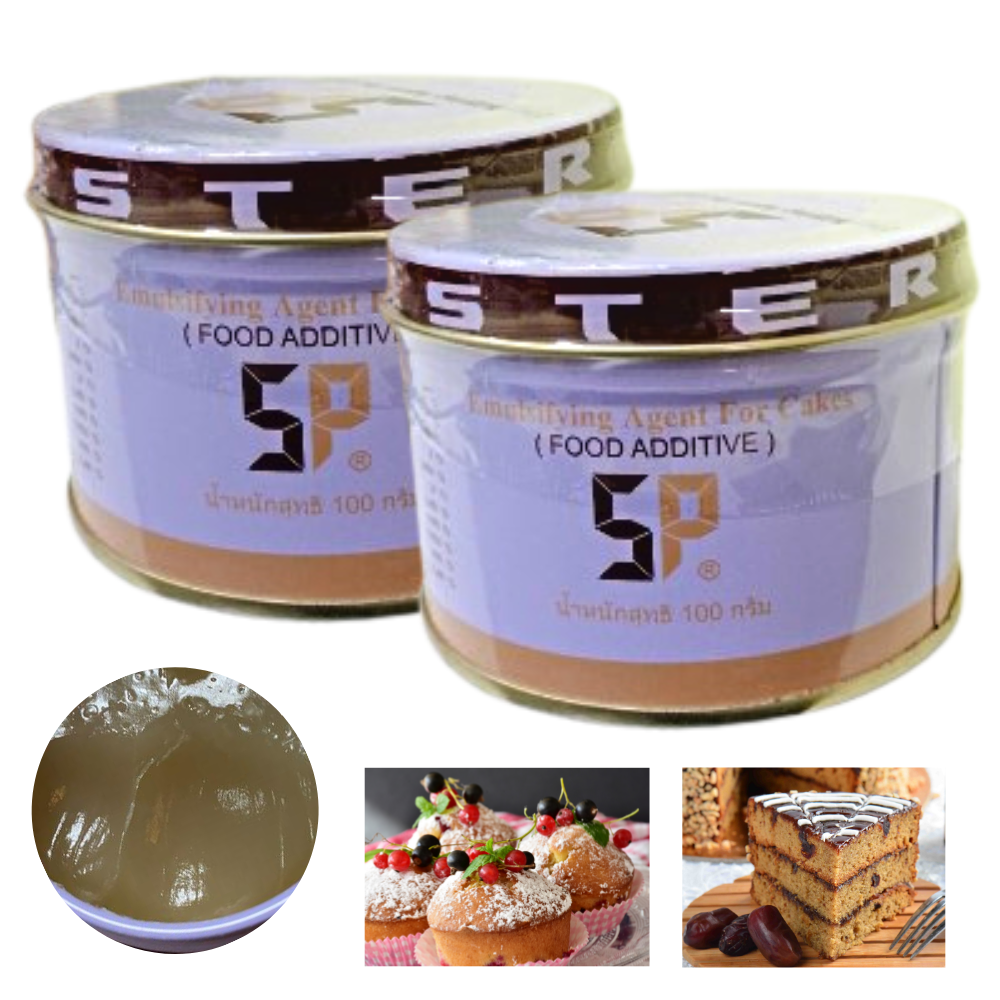Emulsifier In Food Myths and Facts Explained
Why It Is Essential to Incorporate an Emulsifier in Food for Optimum Preference and Quality
Emulsifiers play an essential function in food manufacturing by ensuring the secure blending of immiscible fluids, such as oil and water. They minimize interfacial stress, which avoids the splitting up of active ingredients and adds to a consistent texture. This not only enhances mouthfeel but additionally impacts flavor understanding. Comprehending the need of emulsifiers exposes much deeper insights right into their feature and value in cooking applications. What implications does this have for food development and consumer choices?
Recognizing Emulsifiers: The Basics
Emulsifiers play an essential duty in food science, acting as agents that help with the blending of 2 immiscible liquids, such as oil and water. These compounds have both hydrophilic (water-attracting) and hydrophobic (water-repelling) residential properties, which allow them to maintain solutions. Common emulsifiers include lecithin, found in egg yolks and soybeans, and mono- and diglycerides, stemmed from fats.
The Scientific research Behind Emulsification
When 2 immiscible fluids are incorporated, the process of emulsification ends up being essential for accomplishing a steady blend. Emulsification involves distributing one liquid within one more, generally oil in water or the other way around. This procedure occurs through mechanical frustration, which damages the bigger droplets into smaller sized ones, consequently increasing the area. Without the presence of emulsifiers, these droplets would certainly coalesce, leading to splitting up.
Emulsifiers are molecules with hydrophilic (water-attracting) and hydrophobic (water-repelling) properties. Their one-of-a-kind structure enables them to decrease the interfacial tension between both immiscible liquids, stabilizing the emulsion. This stabilization prevents splitting up and enhances the harmony of structure and flavor. The interactions at the molecular level are necessary for preserving the integrity of the solution, ensuring that food items preserve their desired uniformity and taste. Recognizing this scientific research is considerable for food researchers and manufacturers in developing high-grade food products.
Kinds Of Emulsifiers Used in Food
The sorts of emulsifiers utilized in food can be broadly categorized into natural and synthetic ranges. Typical food emulsifiers, such as lecithin and mono- and diglycerides, play a vital role in enhancing food stability and structure. Comprehending these differences is crucial for appreciating just how emulsifiers contribute to the total top quality of food.
Natural vs. Artificial Emulsifiers
While both natural and synthetic emulsifiers offer the necessary function of maintaining combinations in food, their beginnings and qualities vary markedly. All-natural emulsifiers, stemmed from plant or animal sources, include lecithin, casein, and certain periodontals. They are often perceived as healthier choices, interesting consumers looking for clean-label items. In contrast, artificial emulsifiers, such as mono- and diglycerides, are chemically crafted and may use enhanced stability and performance in a bigger series of applications. These artificial options can be extra economical and offer constant high quality. They may evoke skepticism among health-conscious consumers. Eventually, the option in between all-natural and synthetic emulsifiers depends on the preferred high qualities of the food item, including structure, flavor, and shelf-life stability.
Typical Food Emulsifiers
Emulsifiers play a necessary duty in the food industry, making sure the security and structure of numerous items. Usual food emulsifiers include lecithin, mono- and diglycerides, and polysorbates. Emulsifier In Food. Lecithin, obtained from sources like soybeans and egg yolks, is widely used in baked products and chocolates. Mono- and diglycerides, typically obtained from vegetable oils, boost the creaminess of margarine and gelato. Polysorbates, artificial emulsifiers, are often located in salad dressings and sauces, advertising a smooth consistency. Other emulsifiers such as xanthan gum and guar gum tissue, both all-natural thickeners, also add to the desired structure in various food. Each emulsifier type serves details functions, adding to the overall top quality and appeal of food things

Duty in Food Security
Food stability is substantially affected by the kinds of emulsifiers utilized, which help protect against the separation of active ingredients in different formulations. Emulsifiers such as lecithin, mono- and diglycerides, and polysorbates play crucial roles in keeping the uniformity of items like dressings, sauces, and ice creams. Lecithin, originated from soy or egg yolk, is particularly effective as a result of its natural residential or commercial properties, while mono- and diglycerides boost appearance and rack life. Polysorbates, on the other hand, enhance the stability of oil-in-water emulsions, making them excellent for baked items. The option of emulsifier relies on the particular food application and desired qualities, ensuring that items stay steady, attractive, and of premium quality throughout their intended shelf life.
How Emulsifiers Improve Texture and Mouthfeel
Enhancing the sensory experience of food, emulsifiers play a vital duty in enhancing texture and mouthfeel. These substances facilitate the uniform circulation of active ingredients, allowing for a smoother and creamier consistency in items such as dressings, sauces, and gelato. By maintaining mixes of oil and water, emulsifiers protect against splitting up, causing a cohesive appearance that improves the general eating experience.
Emulsifiers can modify the thickness of food items, contributing to a desirable density or creaminess. This alteration of texture can affect how food feels in the mouth, affecting satisfaction and enjoyment. In addition, by developing a steady solution, emulsifiers aid here preserve the honesty of the item, making sure that the intended mouthfeel is continually supplied in time. In general, the application of emulsifiers is essential for accomplishing the best texture and mouthfeel, eventually elevating the top quality of foodstuff.
The Role of Emulsifiers in Flavor Improvement
Flavor enhancement in cooking applications often hinges on the reliable use emulsifiers. These compounds assist in the mixing of water and oil, allowing for the even distribution of flavor compounds within food products. By producing secure solutions, emulsifiers help to encapsulate and release volatile tastes, boosting the general sensory experience.
On top of that, emulsifiers can boost the understanding of preference by influencing the mouthfeel and appearance of recipes. A smoother, more cohesive product can cause a heightened perception of flavors, making them more delightful and pronounced. In addition, emulsifiers can protect sensitive tastes from degradation, guaranteeing that they continue to be intact throughout handling and storage space.
Emulsifiers in Popular Food Products
Exactly how do emulsifiers add to the appearance and security of prominent food? Emulsifiers play a vital duty in various extensively taken in products. In salad dressings, they guarantee a smooth mix of oil and vinegar, stopping separation and boosting mouthfeel. In gelato, emulsifiers develop a velvety texture by maintaining air bubbles, causing an indulgent and abundant product. Baked goods, such as bread and cakes, take advantage of emulsifiers by boosting volume and crumb framework, causing a lighter and a lot more appealing structure. Furthermore, mayo depends on emulsifiers to preserve its thick uniformity and protect against oil separation. Margarine and spreads also utilize emulsifiers to achieve a spreadable appearance while maintaining security. These instances illustrate the considerable influence of emulsifiers on the top quality and pleasure of daily food items, emphasizing their relevance in modern-day food solution.
The Future of Emulsifiers in Food Innovation
The future of emulsifiers in food technology is marked by significant advancements in technology, leading the way for brand-new formulas. Additionally, the demand for much healthier emulsifier alternatives is increasing, motivating scientists to discover natural and plant-based alternatives. Lasting sourcing practices are likewise becoming crucial, as consumers increasingly focus on environmental obligation in their food selections.
Developments in Emulsifier Innovation
As scientists remain to check out the molecular intricacies of emulsifiers, substantial improvements are emerging that pledge to transform food innovation. Current growths concentrate on creating much more efficient and versatile emulsifiers that enhance texture, stability, and taste in different food items. Technologies in biopolymer-based emulsifiers are acquiring grip, offering enhanced sustainability and performance over conventional alternatives. Additionally, improvements in nanotechnology are making it possible for the design of emulsifiers at the molecular level, which can cause finer solutions and enhanced sensory experiences. These technological developments are not only improving item quality however also broadening the series of applications for emulsifiers in the food market. As these advancements unravel, they are anticipated to redefine culinary possibilities and consumer preferences in the future.
Much Healthier Emulsifier Alternatives
While conventional emulsifiers have played a crucial duty in food production, there is a growing need for much healthier options that straighten with consumer preferences for clean labels and natural active ingredients. Technologies in plant-based emulsifiers, such as those stemmed from soy, sunflower, and flaxseed, have gained popularity due to their perceived health benefits. These alternatives typically contain fewer ingredients and use performance similar to synthetic emulsifiers. In addition, active ingredients like aquafaba, the fluid from cooked chickpeas, have actually become functional emulsifying agents, interesting vegan and health-conscious customers. Emulsifier In Food. The shift towards these healthier emulsifiers not only enhances the charm of food but additionally sustains the pattern of transparency in ingredient sourcing, ultimately promoting consumer trust fund and satisfaction

Lasting Sourcing Practices
Lasting sourcing practices are becoming significantly vital in the development of emulsifiers, showing a more comprehensive commitment to ecological duty within the food industry. Producers are currently focusing on making use of renewable energies, such as plant-based active ingredients, which decreases the carbon footprint connected with typical emulsifiers. This shift not only sustains find more information biodiversity yet additionally promotes moral farming techniques that benefit regional areas. Furthermore, improvements in technology make it possible for the extraction and processing of emulsifiers with lowered environmental influence. By adopting sustainable sourcing, companies improve their brand name picture while meeting customer demand for openness and eco-friendliness. As the food market continues to progress, the integration of sustainable emulsifiers will play a crucial duty in forming future innovations, making sure an equilibrium between high quality and environmental stewardship.
Regularly Asked Concerns
Are Emulsifiers Safe for People With Food Allergies?

Can Emulsifiers Impact the Nutritional Worth of Food?
Emulsifiers can affect the dietary value of food by enhancing nutrient absorption or possibly changing the bioavailability of particular compounds. However, their you could try here results vary commonly relying on the sort of emulsifier and the general food formula.
Exactly How Do Emulsifiers Influence Service Life of Products?
Emulsifiers enhance the shelf life of items by supporting combinations, stopping separation, and decreasing putridity. This stability assists preserve structure and flavor over time, ultimately making certain food continues to be attractive and secure for longer durations.
What Are Typical Natural Emulsifiers Located in Home Kitchens?
Typical natural emulsifiers located in home kitchen areas consist of egg yolks, soy, honey, and mustard lecithin. These components aid maintain mixtures by reducing surface area stress between oil and water, boosting appearance and consistency in different dishes.
Are There Any Kind Of Interest In Synthetic Emulsifiers in Food?
Problems pertaining to artificial emulsifiers in food include prospective digestion issues, inflammatory responses, and web links to obesity. Some research studies suggest these additives might interfere with gut microbiota, raising concerns about their long-term results on wellness and well-being.
Typical food emulsifiers, such as lecithin and mono- and diglycerides, play a vital duty in boosting food security and appearance. Emulsifiers play an essential role in the food industry, making certain the security and structure of numerous items - Emulsifier In Food. Other emulsifiers such as xanthan gum tissue and guar gum tissue, both natural thickeners, additionally add to the preferred texture in numerous food products. Current developments concentrate on producing more versatile and effective emulsifiers that improve appearance, stability, and flavor in various food products. Emulsifiers can posture dangers for people with food allergies, as some emulsifiers are derived from irritants like soy or eggs